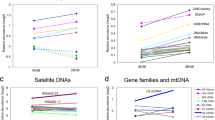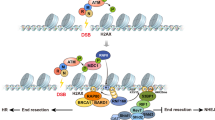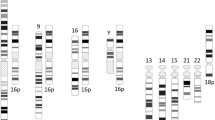Abstract
The chromosome complement of the grasshopper Dociostaurus genei is characterized by the presence of constitutive heterochromatin (C-bands) located in the centromeric regions of all the chromosomes and in the distal regions of some autosomes in the form of supernumerary segments. A sequence analysis was carried out to obtain information about the molecular characteristics of both heterochromatic regions. Two families of tandemly repetitive DNA (DgT2 and DgA3) from D. genei were cloned and characterized. Data obtained from in situ hybridization indicate that these families are located solely in the regions of constitutive heterochromatin. The DgT2 clone is representative of a family of sequences which mainly forms the centromeric C-bands in each chromosome of the complement. The DgA3 family is the major component of the distal C-bands (supernumerary segments) present in most of the autosomal pairs. These results show the existence in D. genei of two different families of repetitive DNA restricted to different chromosomal domains. We discuss these results in the light of the possible role of chromosomal disposition in the maintenance of the differences between heterochromatic DNA from different chromosomal regions and the homogenization of DNA sequences from equilocal chromosomal domains.
Similar content being viewed by others
Article PDF
References
Arnold, M L, Appels, R, and Shaw, D D. 1986. The heterochromatin of grasshoppers from the Caledia captiva species complex. I. Sequence evolution and conservation in a highly repeated DNA family. Mol Biol Evol, 3, 29–43.
Bella, J L, García De La Vega, C, López-Fernández, C, and Gosálvez, J. 1986. Changes in acridine orange binding and its use in the characterisation of hetero-chromatic regions. Heredity, 57, 79–83.
Brown, A K, and Wilmore, P J. 1974. Location of repetitious DNA in the chromosomes of the desert locust (Schistocerca gregaria). Chromosoma, 47, 379–383.
Feinberg, A P, and Vogelstein, B. 1983. A technique for radiolabelling DNA restriction endonuclease fragments to high specific activity. Analyt Biochem, 132, 6–13.
Greilhuber, J, and Loidl, J. 1983. On regularities of C-banding patterns and their possible cause. In: Brandham, P. E. and Bennett, M. D. (eds) Kew Chromosome Conference II, P. 344. George Allen and Unwin, London.
Hewitt, G M. 1979. Orthoptera Animal Cytogenetics 3, Insecta 1 Gebrüder Borntraeger, Stuttgart.
John, B. 1983. The role of chromosome change in the evolution of orthopteroid insects. In: Sharma, A. K. and Sharma, A. (eds) Chromosomes in Evolution of Eukaryotic Groups, vol 1, pp. 1–110. CRC Press, Boca Raton, FL.
John, B. 1988. The biology of heterochromatin. In: Verma, R. S. (ed.) Heterochromatin, pp. 1–147. Cambridge University Press, Cambridge.
John, B, Appels, R, and Contreras, N. 1986. Population cytogenetics of Atractomorpha similis. II. Molecular characterization of the distal C-band polymorphisms. Chromosoma, 94, 45–58.
King, M, and John, B. 1980. Regularities and restrictions governing C-band variation in acridoid grasshoppers. Chromosoma, 76, 123–150.
López-Fernández, C, and Gosálvez, J. 1981. Differential staining of a heterochromatic zone in Arcyptera fusca (Orthoptera). Experientia, 37, 240.
López-León, M D, Neves, N, Schwarzacher, T, Heslop-Harrison, J S, (PAT), Hewitt, G M, and Camacho, J P M. 1994. Possible origin of a B chromosome deduced from its DNA composition using double FISH technique. Chromosome Res, 2, 87–92.
Pendas, A M, Moran, P, and Garcia-Vazquez, E. 1993. Ribosomal RNA genes are interspersed throughout a heterochromatic arm in Atlantic salmon. Cytogenet Cell Genet, 63, 128–130.
Rigby, P W Z, Dieckmann, M, Rhodes, C, and Berg, P. 1977. Labelling deoxyribonucleic acid to high specific activity in vitro by nick traslation with DNA polymerase. J Mol Biol, 113, 237–251.
Rodríguez Iñigo, E, Bella, J L, and García De La Vega, C. 1993. Heterochromatin differentiation between two species of the genus Dociostaurus (Orthoptera: Acrididae). Heredity, 70, 458–465.
Sambrook, J, Fritsch, E F, and Maniatis, T. 1989. Molecular Cloning A Laboratory Manual, 2nd edn. Cold Spring Harbor Laboratory Press, New York.
Sanger, F, Nicklen, S, and Coulson, A R. 1977. DNA sequencing with chain-terminating inhibitors. Proc Natl Acad Sci USA, 74, 5463–5467.
Schweizer, D, and Loidl, J. 1987. A model for heterochromatin dispersion and the evolution of C band patterns. In: Stahl, A., Luciani, J. M. and Vagner-Capodano, A. M. (eds) Chromosomes Today, vol. 9, pp. 61–74. Allen & Unwin, London.
Schweizer, D, Mendelak, M, White, M J D, and Contreras, N. 1983. Cytogenetics of the parthenogenetic grasshopper Warramaba virgo and its bisexual relatives. X. Patterns of fluorescent banding. Chromosoma, 88, 227–236.
Schweizer, D, Loidl, J, and Hamilton, B. 1987. Heterochromatin and the phenomenon of chromosome banding. In: Hennig, W. (ed) Structure and Function of Eukaryotic Chromosomes, pp. 235–254. Springer, Berlin.
Wiegant, J, Nederiof, P M, Van Der Ploeg, M, Tanle, H J, and Raap, A K. 1991. In situ hybridization with fluoresceinated DNA. Nucl Acids Res, 19, 3277–3241.
Author information
Authors and Affiliations
Rights and permissions
About this article
Cite this article
Iñigo, E., Fernández-Calvín, B., Capel, J. et al. Equilocality and heterogeneity of constitutive heterochromatin: in situ localization of two families of highly repetitive DNA in Dociostaurus genei (Orthoptera). Heredity 76, 70–76 (1996). https://doi.org/10.1038/hdy.1996.9
Received:
Issue date:
DOI: https://doi.org/10.1038/hdy.1996.9



